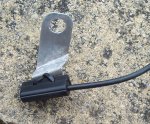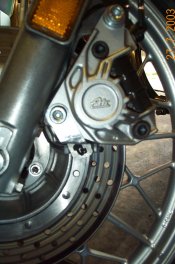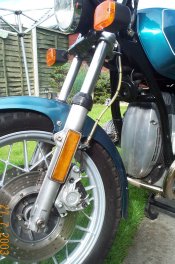 |
 |
 |
 |
 |
 |
 |
 |
 |
 |
 |
 |
 |
 |
 |
 |
 |
 |
 |
 |
 |
 |
 |
 |
 |
 |
 |
 |
 |
 |
 |
 |
 |
 |
 |
 |
 |
 |
 |
 |
 |
 |
 |
 |
 |
 |
 |
|
|
Fitting a Sigma Targa bicycle computer to an R65 (1982) |
|
|
|
Many people have fitted this type of bicycle computer to their machines. Please read Richard Todd's wonderful article which covers all aspects of fitting/calibration www.bmwman.biz and I don't want to repeat it all here. This write up explains how I connected one onto my BMW R65.I chose the Sigma Targa as it was on special offer at £15.99 with free postage. |
|
|
|
Installing the mounting bracket and cable. |
|
|
|
As Richard's write up states you will need to cut the cable and extend it. I cut it mid way, as I was still unsure where I was going to fit the pickup. |
|
|
|
The R65 "dashboard/cowl" is somewhat limited in space. I chose to cut off the wings of the Targa mounting bracket and that enabled it to fit into the hole left by removal of the left blanking plug. I filled in the remaining gap with a piece of black plastic cut to size. |
|
|
|
 |
|
|
|
|
|
I fashioned a piece of aluminium (trial and error to get it right) to fit underneath the bracket and carefully screwed a self-tapping screw through the aluminium plate and into the plastic base of the mounting. You need to be very careful here - I had to grind the screw point flat, as you can't operate the release tag if the screw protrudes through the base. |
|
|
|
 |
|
|
|
|
|
 |
|
|
Sensor. Examination of the forks and reading Richard's article had me scratching my head. There were several ways I could fit it but it just wouldn't look nice! I plumped for constructing a bracket to hang off the brake caliper to which the sensor could be cable (zip) tied. I almost destroyed the dog's stainless steel drinking bowl in search of sheet metal but found a suitable piece of sheet aluminium at the 11th hour. After much trial and error I fashioned the prototype bracket and strapped the sensor to it as shown. |
|
|
|
|
|
|
 |
|
|
|
Magnet. I didn't use the rare earth type like Richard; I bought a couple of Neodymium Iron Boron magnets from Maplins electronics in Birmingham www.maplin.co.uk . They cost about 80p each and are very, very strong.I only needed one. |
|
|
|
|
|
I fitted the bracket/sensor assembly to the lower caliper bolt and epoxyed a super strong magnet to the brake disk between the rivets. |
|
|
|
|
|
 |
|
|
|
|
I had to remove some of the outer sheath of the cable at the fork end and replace it with thinner heatshrink sheathing. This enabled the wires to fit (almost out of sight) in the gap between caliper and fork leg. I soldered some two-core speaker cable to the Targa's cable just above the brake caliper. More shrink-wrap made it look nice! |
|
|
|
|
|
I routed the wires up the metal brake pipe, then up the flexible brake pipe to arrive under the cowling. The wires were secured using miniature cable (zip) ties. I connected the wires under the cowl using detachable plug in connectors, as the cowl has to be removed from time to time. I spun the wheel and it worked! |
|
|
|
|
|
|
|
|
|
|
How it looks fitted: |
|
|
|
A "more professional" bracket has been fashioned out of stainless steel. |
|
|
|
|
 |
|
|
|
|
|
|
 |
|
|
|
|
|
Calibration using the Richard method has been carried out. The existing speedo is 6-8mph below the Targa |
|
|
|
I have no ties with any of the companies mentioned. All work is carried out at your own risk etc. |
|
|
|

|
|
|
|
|
|
Will Hutchins 12th Sept 2004 |
|













